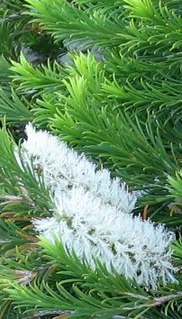
Melaleuca armillaris, commonly known as bracelet honey myrtle, is a plant in the myrtle family, Myrtaceae, and is native to South Australia, Victoria and Tasmania in south-eastern Australia. It is a hardy, commonly grown species, often used as a fast-growing screen plant, but it also has the potential to become a weed. It has become naturalised in Western Australia and parts of Victoria. In its natural state, it grows on coastal cliffs and along estuaries.

Melaleuca linariifolia is a plant in the myrtle family Myrtaceae, and is endemic to eastern Australia. It is commonly known as snow-in-summer, narrow-leaved paperbark, flax-leaved paperbark and in the language of the Gadigal people as budjur. A hardy plant, it flowers prolifically in late spring or summer, making it a popular garden shrub or small tree in temperate places. Melaleuca trichostachya is a similar species but its leaves are arranged differently and the fruits have projecting valves.

Melaleuca fulgens, commonly known as the scarlet honey myrtle, is a plant in the myrtle family Myrtaceae, and is endemic to Western Australia, South Australia and the Northern Territory. It is notable for its showy orange, red or purple flowers, unusual foliage and fruit, and is a popular garden plant. It is a member of Melaleuca, a large and diverse genus whose members range from large trees such as M. quinquenervia, to small shrubs.

Melaleuca ericifolia, commonly known as swamp paperbark, is a plant in the myrtle family, Myrtaceae and the genus Melaleuca, native to south-eastern Australia. It is a rather variable species and some specimens resemble Melaleuca armillaris but its papery bark and smaller, more prolific flower heads distinguish it from that species. It often grows in swampy areas and the draining and clearing of these has reduced the numbers of the species, especially around Port Philip Bay near Melbourne. It is also similar to Melaleuca pustulata, a Tasmanian endemic, but that species only grows in dry heath.

Melaleuca squarrosa, commonly known as scented paperbark, is a plant in the myrtle family, Myrtaceae and is endemic to south eastern parts of Australia, especially Tasmania. It is an attractive shrub with dense foliage and arching branches and it flowers profusely in spring or early summer, bearing spikes of perfumed yellow to white flowers.
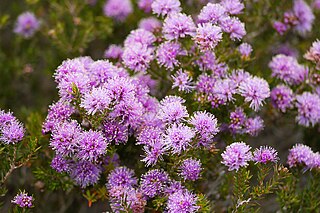
Melaleuca squamea, commonly known as swamp honey-myrtle, is a plant in the myrtle family, Myrtaceae and is endemic to south eastern parts of Australia, especially Tasmania. It is an erect shrub growing in damp and swampy places with crowded leaves and many heads of pink to purple flowers in spring.

Melaleuca wilsonii, commonly known as Wilson's honey-myrtle or violet honey-myrtle, is a plant in the myrtle family, Myrtaceae, native to parts of South Australia and Victoria. It is a shrub with narrow, pointed leaves and heads of purplish-pink flowers on the sides of the branches. It is adaptable to a wide range of soils, frost hardy and often cultivated.
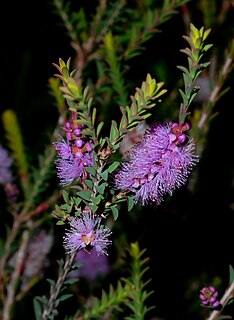
Melaleuca decussata, commonly known as cross-leaf honey-myrtle or totem poles, is a plant in the myrtle family, Myrtaceae native to South Australia and both native and naturalised in Victoria. It is an adaptable shrub, grown in many parts of Australia for its attractive foliage but is regarded as an environmental weed in parts of Victoria.

Melaleuca brevifolia, commonly known as mallee honey-myrtle, short-leaf honey-myrtle, or d'Alton's melaleuca is a shrub or tree in the myrtle family, Myrtaceae, and is native to western Victoria, south-eastern South Australia and the south-west of Western Australia. It is a shrub with rough, corky bark and a large number of heads of white to yellowish flowers on the previous season's growth. It is a moderately hardy garden plant.
Melaleuca apodocephala is a plant in the myrtle family, Myrtaceae and is endemic to the south-west of Western Australia. It is a low, bushy shrub with crowded, grey-green leaves, corky bark and a profusion of creamy-yellow flowers on the sides of the branches.
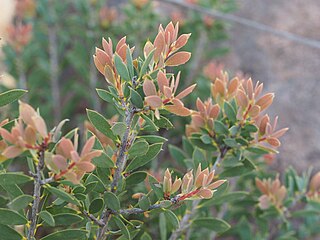
Melaleuca deanei, commonly known as Deane's paperbark, is a plant in the myrtle family, Myrtaceae and is endemic to New South Wales in Australia. It is a shrub with flaky bark, narrow oval leaves and spikes of white flowers in spring and summer. The species only exists in a few isolated populations and is classified as vulnerable.

Melaleuca diosmatifolia, commonly known as rosy paperbark and pink honey-myrtle is a plant in the myrtle family, Myrtaceae and is native to Queensland and New South Wales in Australia. It was formerly known as Melaleuca erubescens but is not closely related to Melaleuca diosmifolia although the species name has the same meaning. It has pointed, non-prickly leaves and cylindrical spikes of pink or purple flowers.

Melaleuca filifolia, commonly called wiry honey-myrtle, is a plant in the myrtle family Myrtaceae, and is endemic to the south-west of Western Australia. It is a woody, twiggy shrub with needle-shaped leaves, greenish flower buds, pink "pom-pom" flower heads and spherical clusters of fruits.

Melaleuca incana, commonly known as grey honey-myrtle, is a plant in the myrtle family, Myrtaceae and is endemic to the south-west of Western Australia and is naturalised in the south of Victoria in Australia. It is commonly grown as a garden plant and produces large numbers of white or creamy yellow flowers, sometimes highly scented, in spring.

Melaleuca micromera, commonly known as wattle honey-myrtle, is a plant in the myrtle family Myrtaceae and is endemic to a small area in the south-west of Western Australia. It is a rare species with unusual foliage and profuse small yellow flowerheads, making it a plant that is suitable for cultivation, if only to protect it from extinction.
Melaleuca sciotostyla, commonly known as Wongan melaleuca, is a plant in the myrtle family, Myrtaceae, and is endemic to the south-west of Western Australia. It is an endangered species with only 476 mature plants known in 2001. It is closely related and very similar to Melaleuca haplantha but has narrower leaves and fewer stamens per flower than that species.

Melaleuca suberosa, commonly known as corky-bark honey-myrtle or corky honeymyrtle, is a shrub in the myrtle family, Myrtaceae, and is endemic to the south of Western Australia. It is a distinctive shrub, recognised by its tiny, crowded leaves, corky bark and pink flowers that appear along lengths of leafless parts of the branches.
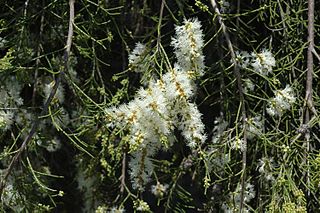
Melaleuca tamariscina, commonly known as bush-house paperbark or tamarix honey-myrtle is a plant in the myrtle family, Myrtaceae and is endemic to central Queensland in Australia. It grows to the height of a small tree with small, scale-like leaves that are pressed against the branches, and has a papery bark and a weeping habit.
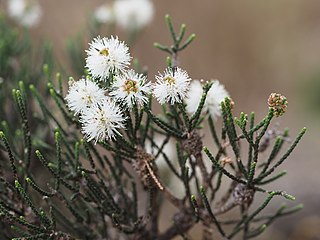
Melaleuca thyoides, commonly known as salt lake honey-myrtle is a plant in the myrtle family, Myrtaceae and is endemic to the south-west of Western Australia. It is an erect shrub with grey, papery or fibrous bark and very small, overlapping leaves on thin branchlets. It is a salt tolerant species often found on the edges of salt lakes.
Melaleuca quercina, commonly known as Oakey bottlebrush is a plant in the myrtle family, Myrtaceae and is endemic to a small area of Queensland in Australia. It is small tree with dark, corky bark and spikes of yellow, cream or pink bottlebrush flowers in spring and summer.

















